| FORTRESS MONASTERIES
Every Chapter of the Adeptus Astartes maintains a mighty fortress monastery, a sanctuary where it trains every new generation of Space Marines and keeps its secrets safe. Great Imperial bastions in their own right, monasteries can take many forms, from towering keeps and sky-scraping spires, to subterranean vaults and seabed domes. Some monasteries are even incorporated into void-borne craft, like the Black Templars Battle Barge Eternal Crusader or the asteroid fortress of the Dark Angels known as The Rock. However, most Chapters’ monasteries are terrestrial, either based on their Chapter Planet, one of their seed worlds, or on an Imperial world by ancient accord with its planetary governor. These imposing edifices are often located in the wilderness regions of their worlds, far from the cities and towns of its other inhabitants. On primitive worlds, ignorant tribesmen will talk of the giant sky-gods and their sacred mountain, warning their children against straying into its shadow. Even on more advanced worlds, the citizens leave the Chapter well alone, often imposing a forbidden zone around the monastery that stretches for hundreds of miles in all directions. In either case, this suits the Chapter well enough, for its battle-brothers are content to stand apart from the world around them and focus on matters closer to home. 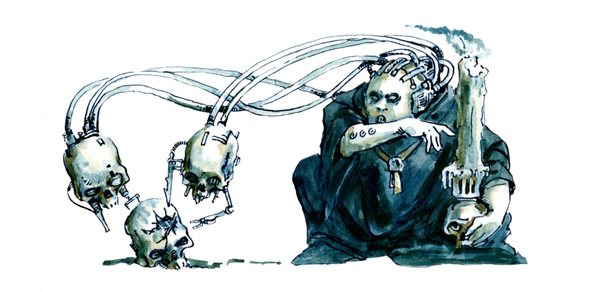 A fortress monastery is where a Chapter will safeguard its heritage and keep its trophies of war. It is rare for more than a fraction of a Chapter to be in residence at any one time, since most of the Chapter’s companies spend years away campaigning across the Imperium. Consequently, life in a fortress monastery tends to follow ancient traditions and faithful routines of prayer and devotion that have gone long unchanged. The Codex Astartes teaches that, to be a great warrior, a Space Marine must be more than his weapons and armour, more than the genetic gifts of his Primarch and more than the war machines provided by his Chapter. He must be strengthened with faith in the Emperor and shielded by indomitable courage. What time a Space Marine does not give over to training will mostly be spent in prayer; even rest is a secondary concern to the rituals of devotion. As a result, a fortress monastery is designed for these needs, its halls studded with alcoves and shrines and its vaults filled with combat arenas and firing ranges. So that the battle-brothers might concern themselves only with honing their body and spirit, the menial tasks of the fortress monastery are dealt with by Chapter serfs. These lay-servants are drawn either from local populations or sometimes from failed recruits, allowing them to serve despite not becoming Space Marines. They clean the vast vaulted chambers and prepare the battle-brothers’ spartan meals. When work is too intricate or complicated for servitors, it is the Chapter serfs who tend to the task for their super-human masters, moving like shadows through the halls and catacombs of the monastery. Though they have a trusted place beside the battle-brothers they serve, they remain largely invisible to them, just another function of the monastery which allows them to focus on the needs of their warrior life. 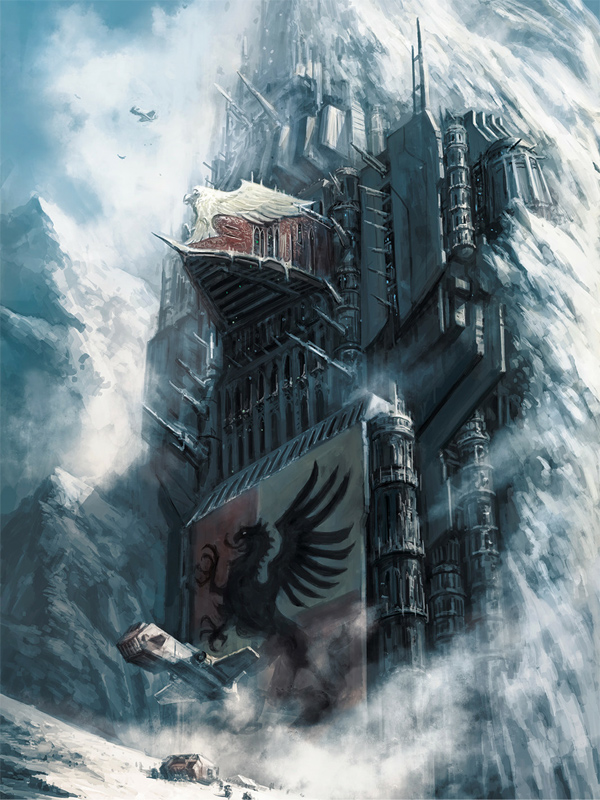 Each fortress monastery is unique to its Chapter and the world upon which it stands. However, most share common chambers and rooms, built as they are in part upon the teachings of the Codex Astartes. Below are listed some typical examples of these chambers, their uses and the part they play in the everyday existence of a Space Marine when he is between campaigns. As the name implies, a Space Marine fortress monastery is constructed to withstand an assault from any determined foe. Ringed with high walls or built into the heart of a mountain or other natural defence, the monastery comprises dozens of ramparts, watchtowers and bastions. Every entrance is sealed with heavy adamantium, ceramite or stone gates, barred by ancient and complex locks, often keyed to the unique genetic code of the Chapter’s battle-brothers. The monastery will also often incorporate shimmering void shields, domes of power enveloping the entire structure to ward off orbital bombardments or assaults from Titans. Covering every entrance and approach, macro-cannon turrets, heavy bolter bunkers and missile batteries scan the horizon for foes, ready to unleash their deadly ordnance at a second’s notice. Whether on the remotest of worlds, or firmly within the grasp of the Imperium, a fortress monastery is always ready for war. The lands beyond its walls and gates are always considered hostile, and only the most trusted allies are admitted entrance. In addition to thick walls and gates, the Chapter will create other kinds of defences to further discourage assault. These can consist of almost anything that would bring woe to an attacker, be they grav-mine nets, vortex-pits or eletro-pylons, each one capable of killing entire regiments. Natural defences are frequently incorporated into a fortress monastery, and were doubtless a motivating factor for their ancient builders. On mundane Imperial worlds, this might mean placing the fortress high atop a remote peak, deep within the heart of a forbidding jungle or embedded beneath a frozen polar ice cap. Death worlds provide alternative means of repelling the foe, such as forests of carnivorous plants, airless plains bombarded with solar radiation or even shifting tectonic seas of magma. The Chapter’s fleet is also maintained at the fortress monastery when not transporting battle-brothers or engaging enemies across the galaxy. Any ships present add to the might of the fortress’ defences, either from within shielded docking arrays or from geosynchronous orbit above, their heavy guns scanning the surrounding void. 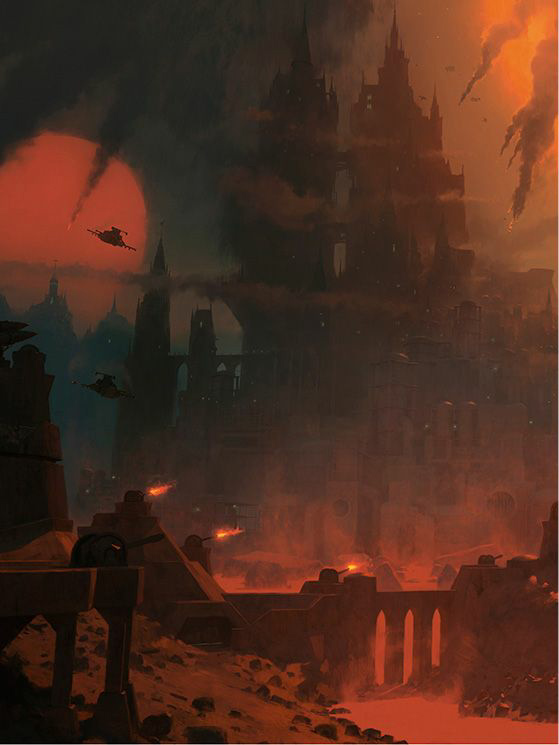 A fortress monastery will often have a large entrance chamber, designed to convey the might of the Chapter and awe all who walk through its great gates. Known as the great hall, this cyclopean room is lined with ceiling-scraping statues of heroes, its walls carved with reliefs depicting the glorious history of the Chapter. An emissary led into the hall must pass under the watchful gaze of these stone and bronze giants, his eyes drawn up into the shadows of the vaulted ceiling where frescos show bloody battles and scenes of ancient heroism. In the centre of the chamber, the Chapter’s symbol will often dominate the floor, easily a hundred metres across, so that none may doubt whose fortress it is they stand in. The Great Hall is used not only to display the glory and power of the Chapter, but is also large enough for a full company to assemble. Space Marines of the Chapter will sometimes gather here in the presence of their ancestors before embarking on a mission or campaign. It is written in the Codex Astartes that a Chapter must be mindful of its heritage, the genetic past that connects it to its Primarch and ultimately to the Emperor. Each Chapter has its own means and methods of honouring their heroes and forbears, but many use the Great Hall for their rituals. The Great Hall is the glorious face of the Chapter, hiding its secrets, sins or shame, behind a facade of grand monuments. The statues and mosaics of the hall are the outward image of the Chapter, hence its location just beyond the fortress monastery’s main entrance, and they show visitors what the Chapter wants them to see. Any flaws the Chapter possesses are hidden deep within the fortress, their taint far from the glory reflected by the Great Hall. 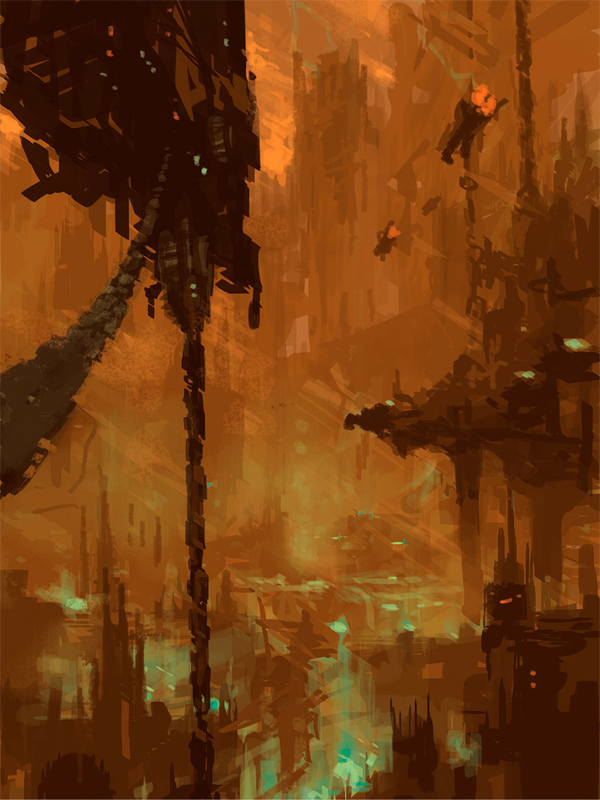 While the fortress monastery is primarily a venue of worship, training and defence, it is also a place where Space Marines and their servants take rest. Each battle-brother has his own cell within the monastery, which – depending on the creed of his Chapter – might be a bare stone room bereft of ornamentation or a warrior’s refuge, its walls hung with weapons and trophies. In either case, a Space Marine’s cell is unique to him, and for as long as he lives it will remain his own, a place where he can pray alone and contemplate the glory of the Emperor. By contrast, the Chapter serfs that maintain the fortress live in sprawling dormitories which, though still basic, are more spacious and comfortable than the cells. This is partly because the Chapter serfs live their whole lives within the walls of the monastery, and as a place where the battle-brothers rarely tread, the dormitories become their homes. Indeed, many Imperial citizens would be impressed by the life a Chapter serf leads, the Chapter ensuring the wellbeing of those that tend to the needs of its battle-brothers. Even Chapter Masters will seldom have cells more impressive than those of an ordinary battle-brother. Though they might have war rooms and audience chambers in which they conduct the business of the Chapter, their own personal quarters are usually simple – as befits a warrior-monk, regardless of his station. When a Space Marine dies the Chapter serfs clear out his cell and make sure that his possessions are either buried with him or, if this is not possible, stored within the depths of the fortress. Many monasteries have extensive catacombs beneath their walls holding hundreds of centuries worth of trinkets, trophies and honour tokens from countless generations of battle-brothers, each one bearing the name and deeds of the Space Marine. Often a group of serfs will spend their lives extending these catacombs and enshrining these belongings, the locations and contents of old tunnels lost when they die, until the fortress rests on an uncharted maze of the dead. 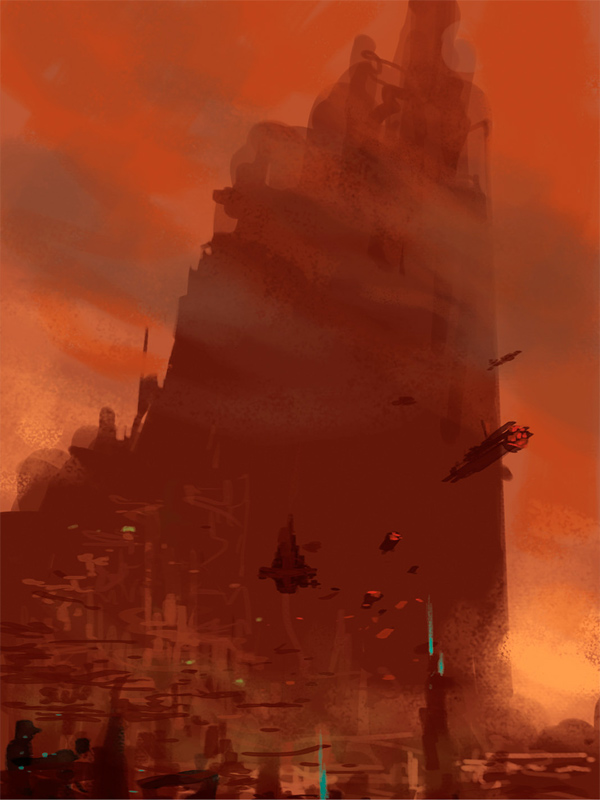 Entire levels or wings of a fortress monastery will be given over to the forging of weapons and the maintenance of the Chapter’s war machines. This is the domain of the Techmarines. As secretive as their Adeptus Mechanicus brothers, they work their rituals and prayers behind sealed doors, coaxing machine spirits to life or constructing new ordnance for their battle-brothers. While a Chapter receives the bulk of its ammunition, small arms and armoured fighting vehicles from the Munitorum, the forge worlds of the Imperium producing the finest weapons for its greatest warriors, a degree of its weapons come from within the Chapter itself. This is especially true of weapons unique to the Chapter, such as relic blades, specialised bolter rounds or ancient suits of armour. These weapons are created and maintained in the forges of the fortress monastery, the Techmarines and servitor workers casting gun casings, chain blades and ceramite plates. Even without the aid of the Munitorum, once a Space Marine Chapter has created a fully working forge it is capable of sustaining its own combat needs. Even in the absence of the Techmarines the forges are never cold, shifts of specially created servitors endlessly churning out bolter shells, frag grenades and other light ordnance. Chambers close to the forges are therefore never quiet, and constantly reverberate to the clang of hammers and the roar of autobellows keeping the fires hot. To a battle-brother these are comforting sounds, telling him his guns will not fail him in combat, nor will his clip ever run dry. To house the war materiel of the Chapter huge shielded silos are built into its central recesses. Protected from attack by metres of adamantium, ferrocrete, null shields to dampen energy weapons and reactive blast doors, they are always piled high with crates of shells, rounds and missiles. Racks of boltguns, meltaguns, and heavier weapons line the walls, each one wrapped in the purity seals of the Master of the Forge, attesting to its blessed craftsmanship. Connecting these silos to the rest of the fortress, a network of shell-hoists and ammo-conveyors ring the central chambers. Legless, sightless servitors hang suspended over the moving platforms and belts, their wizened fingers sorting rounds and shells by size and shape. Thus, from ammo-shrines throughout the monastery, a battle-brother can reload his boltgun or summon a weapon with which to fight any would-be invader. 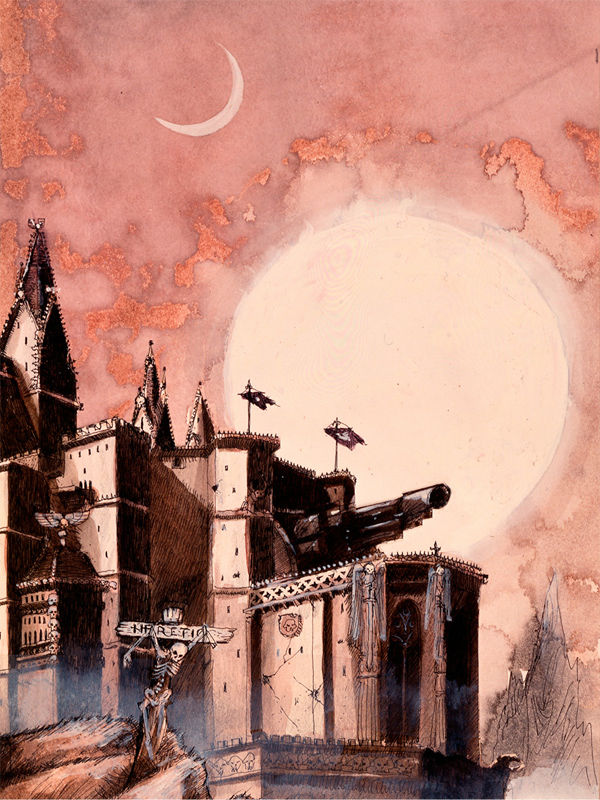 Next to the forges and armouries, the Apothecarion is amongst the most well defended parts of a fortress monastery. This is where the Apothecaries safeguard the Chapter’s genetic heritage and tend to its injured Space Marines. It is rare for a Space Marine to suffer lingering damage from combat; most wounds are not strong enough to kill a battle-brother, either healing quickly or being overcome by auxiliary organs, internal vascular control or metabolic cycling. By the time a Space Marine has returned to the Chapter’s fortress monastery, any such damage will have healed or been patched up in the field by Apothecaries. The Apothecarion therefore usually deals only with those Space Marines who require new organs or limbs, or psycho-surgery for excessive mental trauma. Even these more complex operations are quick to carry out given a Space Marine’s high metabolic healing rate and tolerance for pain. Far more important than the tending of wounded battle-brothers, the Apothecarion serves as the repository for the Chapter’s gene-seed. It is this part of a Space Marine that holds his genetic code and the ancestry of his Primarch. With this gene-seed an Apothecary can create a new Space Marine, implanting it into a man and letting it grow new organs, altering his physiology until he develops into a full battle-brother. The gene-seed of a Chapter represent both its past and its future, holding the DNA of their greatest heroes as well as the potential of future generations of Space Marines. To protect the gene-seed from interference or loss they are usually kept in spiralling stasis-wells: long cylindrical vaults lined with hundreds of sealed stasis-caskets, each one holding a single shielded vial containing a progenoid gland in glistening embryonic fluid. Only the Chapter Master and Chief Apothecary are allowed access to the stasis-well; heavy adamantium blast doors keyed to their unique bio-signatures surround it, and ranks of bolter turrets are constantly vigilant for trespassers. It is the responsibility of the Apothecaries not just to keep and maintain the gene-seed but also to ensure its purity. Many Chapters have fallen from the light of the God-Emperor by allowing corruption and mutation to creep into their gene-seed, resulting in insanity and aberration among their battle-brothers. The pristine white chambers of the Apothecarion are where this work is done, and the biological discoveries of the Apothecaries recorded. These are secrets that must be well defended against friend and foe alike. 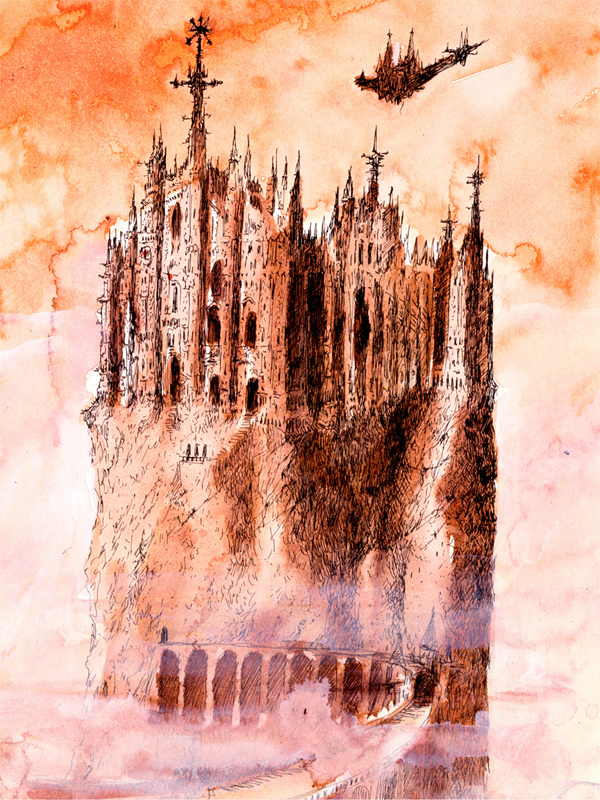 The Librarius is the central store of all the Chapter’s history and lore. Filled with ancient tombs and sacred scrolls, every piece of text ever laid down by the Chapter or relevant to its existence is housed within. Overseen by the Librarians, it is a silent and holy place of whispered secrets and hidden truths. Few battle-brothers are permitted access to the Librarius, its reserve of knowledge restricted to the Chapter Master and his advisors. In this capacity, the Chief Librarian is usually either recording lore for safekeeping or seeking it from among the dusty shelves and scroll-vaults. A Librarius will often be created around a central pillar, its racks and shelves of books and scrolls spiralling out in ever widening circles. Branching from a central large round chamber, antechambers will hold tomes on specific lore or proscribed texts, many sealed permanently to guard against the heretical writings they contain. On a web of gantries, Lexicanium Librarians catalogue and order the books, assisted by Chapter serfs, the latter often blinded lest their gaze fall upon a forbidden word or dark illumination. The disposition of lore within the Librarius varies from Chapter to Chapter, each placing varying degrees of importance on different texts or having more or fewer relics in their possession. However, in many cases the central pillar of the Librarius will house the Chapter’s oldest copy of the Codex Astartes, held upon a stasis plinth or projected by holo-reflection. It is the honour of the Chapter Master and Chief Librarian alone to be able gaze upon this sacred tome, many lords of the Adeptus Astartes drawing their inspiration and resolve from the ancient book in times of darkness. Beyond the central pillar, rows of written works, data-slates, chronicle stones and memory crystals line the walls, reaching up dozens of metres from dusty floor to shadowy ceiling. Each one is a piece of lore important to the Chapter, the account of a great battle, the final words of one of its heroes or the secrets of a vanquished foe. Imperial scholars speculate that there are details of lost xenos empires, terrible forgotten weapons and entire sectors of space that exist only in the Librarius’ of the Adeptus Astartes. Such knowledge remains forever the dominion of the Chapter, and it is doubtful any outside of its masters will even know of its existence. 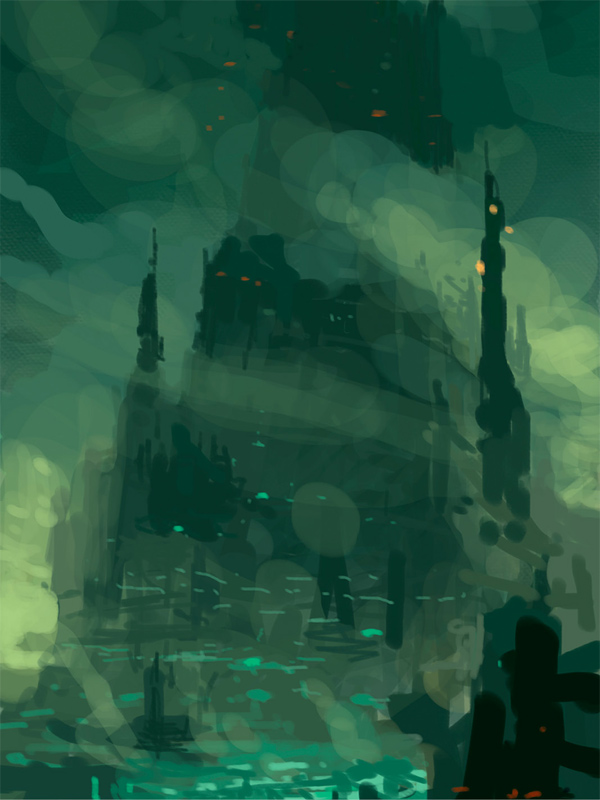 The Space Marines honour their dead – each fallen battle-brother is borne back to the fortress monastery to be interred with his ancestors. Though not all battle-brothers make this final journey, the Chapter endeavours to see it done, and even on remote worlds or far-flung war zones there will be Chapter serfs or battle-brothers whose responsibility it is to gather up the dead and convey them back to the monastery. Once the Apothecaries have removed his gene-seed, a Space Marine has served his final duty to the Imperium, and is ready for rest. His brothers, especially those from the squad or company in which he served, will say prayers over him before he is taken away, honouring his deeds and remembering his bravery in battle. The body then finds its way back across the stars and eventually into the crypts of the fortress monastery. The nature of these crypts depends on the world upon which the fortress stands, and in many cases the customs of the Chapter itself. Some will take the form of subterranean vaults, their walls carved with recesses and filled with the bones of long-dead battle-brothers, while others might be shadowy chambers lined with rows of sealed stone caskets, the lid of each carved into the likeness of the Space Marine it inters. In some cases the world’s environment will be used, the bodies of the fallen frozen into the depths of a polar mountain, preserved in the airless heart of an asteroid or cremated in the caldera of a seething volcano. A fortress monastery is where a Space Marine is made, where he is trained and where he lives his life between campaigns. In the end, when his duty is finally done, it is also fittingly where his body is laid to rest. 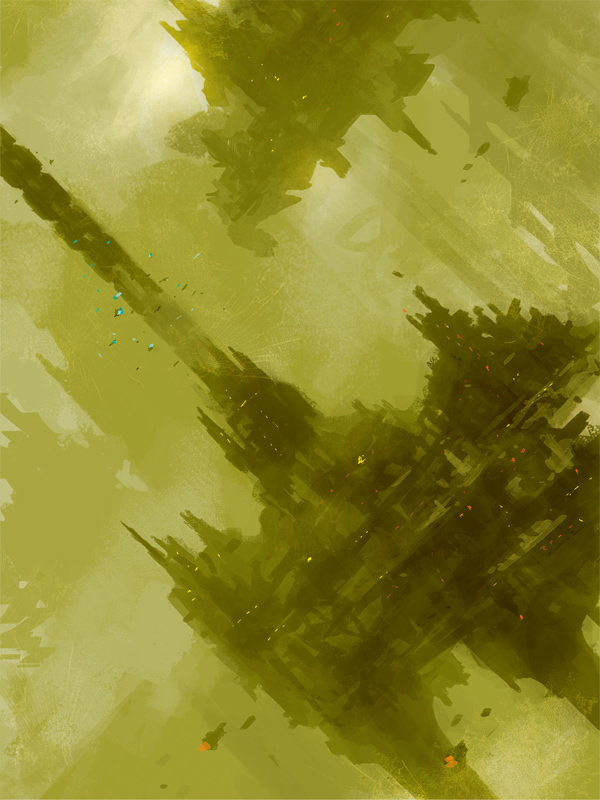
|